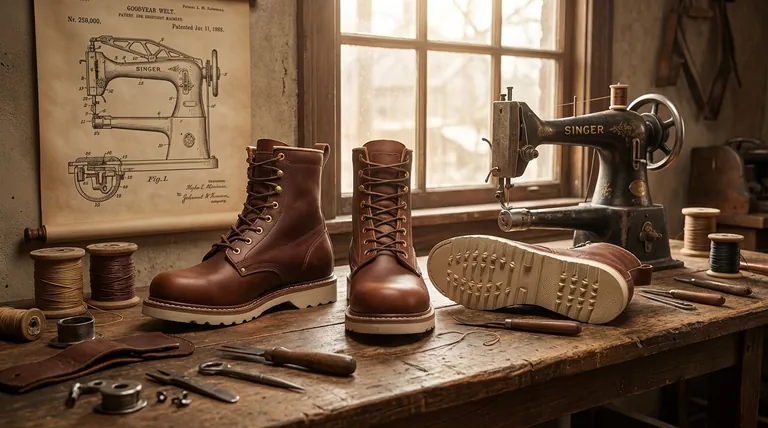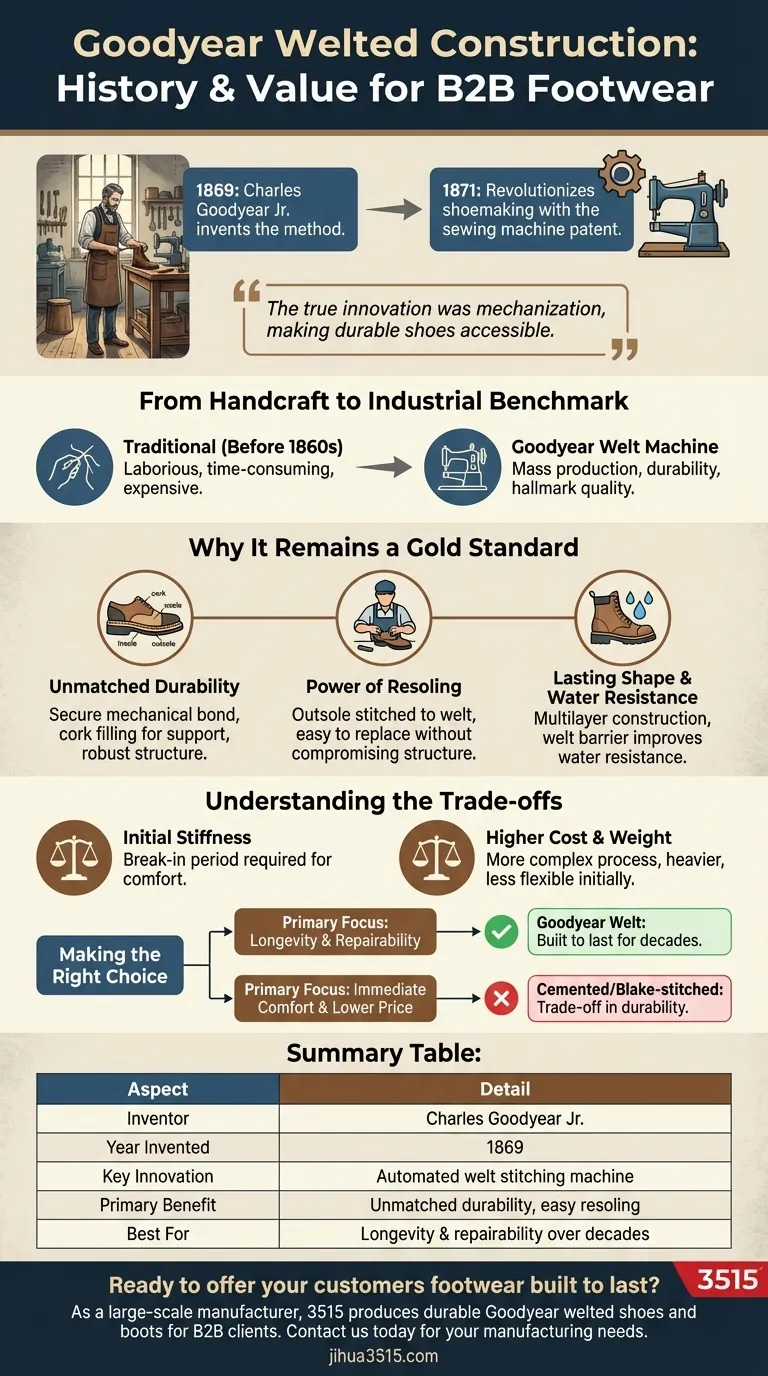The Goodyear Welted construction method was invented by Charles Goodyear Jr. in 1869. He subsequently patented the revolutionary sewing machine that automated the process in 1871, mechanizing what was once a laborious hand-sewn technique and setting a new standard for high-quality footwear.
The true innovation of the Goodyear Welt was not just the construction itself, but its mechanization. This breakthrough made highly durable, long-lasting, and easily repairable shoes accessible beyond the world of bespoke, hand-sewn footwear.

From Handcraft to Industrial Benchmark
Before the 1860s, attaching a sole to a shoe upper was a time-consuming manual process. The Goodyear Welt machine changed everything, enabling the mass production of quality footwear and cementing its place as a hallmark of durability.
The Challenge of Traditional Shoemaking
Traditionally, creating a welted shoe was an intensive craft reserved for skilled artisans. The process of hand-stitching the sole, upper, and a leather strip (the welt) was slow and expensive, limiting access to such durable shoes.
The Role of the Machine
Charles Goodyear Jr.'s invention was a machine that could rapidly stitch the welt to the shoe's upper and insole. This single innovation replaced the most difficult hand-sewing step, allowing factories to produce exceptionally sturdy shoes at an unprecedented scale.
Why the Goodyear Welt Remains a Gold Standard
Over 150 years later, this method is still considered one of the finest for shoe construction. Its longevity is a direct result of its intelligent design, which prioritizes durability and repairability.
Unmatched Durability
Goodyear welting creates a secure, mechanical bond between the shoe's components. A cork filling is added between the insole and outsole, which provides support and molds to the wearer's foot over time, while the multiple layers create a robust structure.
The Power of Resoling
This construction method's most significant advantage is that it is fully resoleable. Because the outsole is stitched to the welt and not directly to the upper, a cobbler can easily remove the old sole and attach a new one without compromising the shoe's structure.
Lasting Shape and Water Resistance
The multilayer construction helps the shoe maintain its original shape for years, even after multiple repairs. The welt also creates a small cavity around the edge of the sole, providing a barrier that improves water resistance compared to more direct sole attachments.
Understanding the Trade-offs
While the Goodyear Welt is a superior construction method, it's important to recognize its specific characteristics. Its strengths in durability come with trade-offs in other areas.
Initial Stiffness
Goodyear welted shoes and boots are famously stiff when new. The robust layers and cork footbed require a "break-in" period for the shoe to soften and conform to your foot.
Higher Cost and Weight
The complexity of the process and the quality of materials required make Goodyear welted footwear more expensive. The additional layers also make the shoes heavier and less flexible than those with cemented or Blake-stitched soles.
Making the Right Choice for Your Goal
Ultimately, the value of a Goodyear Welt depends entirely on your priorities for the footwear.
- If your primary focus is maximum longevity and repairability: The Goodyear Welt is the definitive choice, allowing you to invest in a pair of shoes that can last for decades with proper care.
- If your primary focus is immediate comfort and a lower price point: You may prefer a cemented or Blake-stitched shoe, accepting the trade-off in long-term durability and ease of resoling.
Choosing a Goodyear welted shoe is an investment in quality and craftsmanship that is built to last.
Summary Table:
| Aspect | Detail |
|---|---|
| Inventor | Charles Goodyear Jr. |
| Year Invented | 1869 |
| Key Innovation | A machine to automate welt stitching |
| Primary Benefit | Unmatched durability and easy resoling |
| Best For | Longevity and repairability over decades |
Ready to offer your customers footwear built to last?
As a large-scale manufacturer, 3515 produces a comprehensive range of durable Goodyear welted shoes and boots for distributors, brand owners, and bulk clients. Our production capabilities ensure you receive the highest quality footwear, combining time-tested construction with modern efficiency.
Contact us today to discuss your manufacturing needs and how we can build lasting value into your product line.
Visual Guide

Related Products
- Wholesale Durable Leather Work Boots | 8-Inch Goodyear Welt Manufacturer
- Durable Goodyear Welt Leather Work Boots for Wholesale & Private Label
- Durable Leather Work Boots for Wholesale & Custom OEM Manufacturing
- Wholesale Safety Boots Manufacturer for Custom & Private Label Orders
- Premium Grain Leather Safety Boots for Bulk Supply
People Also Ask
- How should new leather work boots be broken in? A Guide to Comfort and Durability
- What is the complete process for deep cleaning leather work boots? A Step-by-Step Guide to Preserve Your Investment
- What makes work boots durable? The 3 Key Factors for Long-Lasting Footwear
- Why might it be beneficial to pre-heat the boots before applying wax? Achieve Deeper, Longer-Lasting Protection
- What are the best practices for storing leather work boots? Preserve Your Investment for Years



















